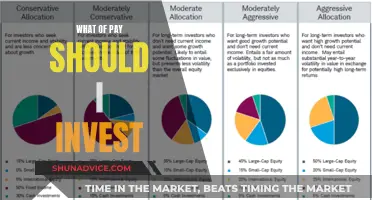
Saving and investing are both important concepts for building a sound financial future, but they are not the same thing. Saving is putting money aside for future goals, such as buying a car or the down payment for a house, and it can also provide a cushion in case of an emergency. On the other hand, investing is the process of buying an investment product with the expectation that your money will earn even more money over time. While saving typically results in a lower return with virtually no risk, investing offers the opportunity to earn a higher return but comes with the risk of losing some or all of the funds invested.
| Characteristics | Values |
|---|---|
| Definition | Saving is putting money aside for future use. |
| Investing is using money to buy assets that might increase in value. | |
| Risk | Saving is low-risk. |
| Investing always involves risk. | |
| Returns | Savings accounts generally earn a lower return than investments. |
| Investments typically have the potential for higher returns than savings accounts. | |
| Time horizon | Saving is typically for the short term. |
| Investing is typically for the long term. | |
| Liquidity | Savings accounts offer ready access to cash. |
| Investments may take longer to access than savings. | |
| Purpose | Saving is often for emergencies or large purchases. |
| Investing is often for retirement or education. |
What You'll Learn

Savings accounts vs investment accounts
Savings accounts and investment accounts are both important for building a sound financial foundation, but they are not the same thing. While both can help you achieve a more comfortable financial future, it is essential to understand their differences and when it is best to save or invest.
Savings Accounts
Saving typically involves putting money aside gradually into a bank account or similar product, such as a certificate of deposit (CD). People generally save for specific goals, like buying a car, a down payment on a house, or building an emergency fund. Savings accounts offer ready access to cash and involve minimal risk. Your funds are typically insured up to a certain amount, and you can earn interest on your balance. However, savings accounts usually offer lower returns compared to investments, and there is a chance of losing purchasing power over time due to inflation.
Investment Accounts
Investing, on the other hand, involves using your money to buy assets that might increase in value, such as stocks, property, or shares in a mutual fund. Investing offers the potential for higher returns than savings accounts, especially over the long term. It is a way to achieve long-term financial goals, such as saving for a child's education or planning for retirement. However, investing always involves risk, and there is no guarantee of returns. It may also take longer to access your invested funds, depending on the type of investment.
When to Save vs. When to Invest
The choice between saving and investing depends on your financial goals, risk tolerance, and time horizon. If you need money in the short term (within the next few years) or want to build an emergency fund, saving in a high-yield savings account or money market fund is usually the better option. Saving is also generally recommended if you have high-interest debt, as it is important to pay this off before investing.
On the other hand, if you are saving for long-term goals and can keep your money invested for at least five years, investing may be a better choice. Investing is crucial for achieving long-term goals, such as retirement, and can help your money grow more aggressively. However, it is important to remember that investing always carries the risk of losing some or all of your investment.
Retirement Reinvented: Exploring the Top Investment Havens for Savvy Seniors
You may want to see also

Short-term vs long-term goals
When it comes to short-term versus long-term goals, it's important to understand the differences between short-term and long-term investments and how they can help you achieve your financial objectives.
Short-Term Investments
Short-term investments are typically held for one year or less, with most investors holding them for a few months, weeks, or even days. These investments are often characterised by high volatility and high liquidity, allowing investors to profit from short-term price movements. Common short-term investments include stocks, options, and ETFs. Investors use these assets to fund short-term financial goals, such as emergency funds or large purchases.
Long-Term Investments
On the other hand, long-term investments are held for more than a year, with most investors holding them for several years as part of a long-term strategy. These investments are expected to gain value slowly and steadily over time. Examples include real estate, mutual funds, and bonds. Long-term investments are common in retirement accounts and college funds, where the focus is on slow but consistent growth.
Key Differences
The main difference between short-term and long-term investments is the time horizon. Short-term investments are held for a shorter duration, while long-term investments are held for years or even decades. Additionally, short-term investments often provide more stable returns, while long-term investments carry more risk.
Key Similarities
Despite their differences, short-term and long-term investments share the common goal of building wealth. Both types of investments involve some level of risk, and neither guarantees a profit.
The choice between short-term and long-term investments depends on your financial goals, time horizon, and risk tolerance. Short-term investments are suitable for funding short-term goals, such as emergency funds or large purchases, while long-term investments are ideal for retirement planning, saving for a child's education, or buying a house. It's important to consider the potential returns, risk factors, and liquidity needs before deciding which type of investment to pursue.
Unit Investment Trusts: A Smart Choice for Long-Term Wealth Building
You may want to see also

Risk and volatility
While saving and investing are both important components of a healthy financial plan, they are not the same thing. The biggest difference between the two is the level of risk taken. Saving typically involves low risk and low return, while investing involves higher risk and higher potential returns.
When it comes to risk, it's important to understand that there are different types. Investment risks fall into two main categories: systemic (or market) risk and unsystematic (or specific) risk. Systemic risk refers to the possibility of losing value based on the overall market performance, while unsystematic risk refers to the possibility of losing value based on the performance of a particular industry or business. There are also various types of systemic and unsystematic risks, such as liquidity risk, exchange-rate risk, commodity risk, country risk, business risk, operational risk, interest rate risk, inflation risk, and political risk.
Volatility, on the other hand, is a statistical measure of the dispersion of returns for a given security or market index. It is often associated with big price swings, either up or down. Volatile assets are generally considered riskier because their prices are less predictable. There are several ways to measure volatility, including standard deviation, beta coefficients, option pricing models, and historical volatility.
When deciding whether to save or invest, it's crucial to consider your financial goals, risk tolerance, and time horizon. If you have short-term goals or need access to your money in the near future, saving is generally a better option as it is lower risk and provides more liquidity. If you have longer-term goals and are comfortable with taking on more risk, investing may be a better choice as it offers the potential for higher returns.
It's also important to note that risk and volatility are not the same as uncertainty. Uncertainty refers to the unknown or unpredictable events that can impact the value of an investment. While volatility measures the magnitude and frequency of price changes, uncertainty looks at the likelihood of unexpected events occurring.
In summary, understanding the concepts of risk and volatility is crucial for making informed financial decisions. By considering the different types of risks and ways to measure volatility, individuals can make more informed choices about saving and investing to achieve their financial goals while managing their risk exposure.
The Spectacle of Snapchat: Why Investors Keep Faith Despite Lack of Profit
You may want to see also

Liquidity and accessibility
Liquidity
Liquidity refers to the efficiency or ease with which an asset or investment can be converted into cash without significantly impacting its market price. It describes how quickly and easily an asset can be turned into cash. The more liquid an asset is, the easier it is to convert it back into cash.
Cash is the most liquid asset, while tangible items like real estate, fine art, and collectibles are generally less liquid. Other liquid assets include stocks, bonds, treasury bills, and precious metals.
When considering the liquidity of investments, it's important to evaluate the market liquidity and accounting liquidity. Market liquidity refers to the efficiency of a market in facilitating the buying and selling of assets at stable prices. On the other hand, accounting liquidity assesses an individual's or company's ability to meet their financial obligations with their liquid assets.
Accessibility
Accessibility refers to the ease of accessing your funds or investments. Savings accounts, for example, provide high accessibility, allowing you to withdraw your funds at any time without penalties. On the other hand, investments like stocks and bonds may have varying levels of accessibility depending on the specific type of investment and the market conditions.
It's important to note that the accessibility of investments can be influenced by factors such as bid-ask spread, trading volume, market depth, and withdrawal restrictions. These factors can impact the ease and speed of converting investments into cash.
In summary, liquidity and accessibility are crucial considerations when deciding between saving and investing. They determine how quickly and easily you can access and utilise your funds, which is essential for financial planning and responding to unexpected financial needs.
Salary and Investment: A Correlation
You may want to see also

Returns and growth
While saving is a great way to build a financial safety net, investing is a way to grow your money over time. Savings accounts are a safe and low-risk way to store money, but they offer low returns. On the other hand, investing in financial instruments such as stocks, bonds, and mutual funds offers the potential for higher returns over the long term.
The Standard & Poor's 500 stock index (S&P 500) has returned about 10% annually, though returns can fluctuate from year to year. Investing in the stock market through exchange-traded funds (ETFs) is a common option for beginners, as ETFs are a collection of securities that track an index like the S&P 500.
Another way to grow your money over time is by investing in a 401(k) retirement plan. This type of account offers tax benefits, as contributions are deducted from your taxable income, and investments grow tax-deferred.
It's important to note that investing always involves risk, and there is no guarantee of making money. The value of investments can fluctuate, and there is a chance of losing money. Therefore, it's recommended to have a diverse portfolio and to choose investments that align with your risk tolerance and goals.
When deciding between saving and investing, it's crucial to consider your financial situation, goals, and risk tolerance. If you need money in the short term, saving is generally a better option. However, if you're looking to grow your wealth over time and can tolerate some risk, investing may be a more suitable choice.
Additionally, it's important to have an emergency fund covering three to six months' worth of expenses before investing. This ensures that you have a safety net in case of unexpected expenses or financial setbacks.
Navigating the CD Investment Landscape: A Guide to Smart Purchasing
You may want to see also
Frequently asked questions
Saving is generally considered safer than investing, but it may not result in as much accumulated wealth over time. The pros of saving include: it's usually a safe bet, it's easy to do, and you can access the funds quickly. The cons of saving include: returns are low, and you may lose purchasing power over time due to inflation.
Investing has the potential for higher returns than saving, but it always involves some level of risk. The pros of investing include: the potential for higher returns, the ability to grow your wealth over time, and the opportunity to achieve long-term financial goals. The cons of investing include: there is no guarantee of making money, there is a risk of losing money, and it requires discipline and a long-term perspective.
Saving is generally recommended for short-term financial goals, such as buying a new phone or laptop, or for building an emergency fund. Investing is typically recommended for longer-term goals, such as saving for retirement or a child's college education. It's important to consider your financial situation, goals, and risk tolerance when deciding whether to save or invest.







